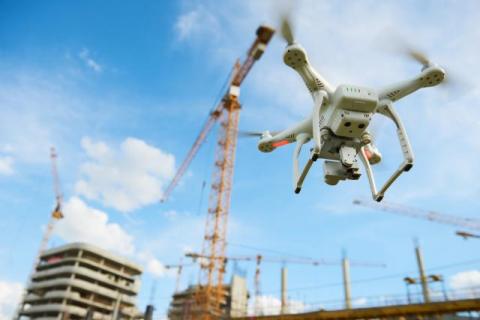Technology innovations improving safety in the construction industry
June 26, 2019According to OSHA, the construction industry accounts for one out of five worker deaths annually. It comes as no surprise that construction sites – populated with heavy machinery, power tools, and scaffolding – can be dangerous. If you add construction-related non-fatal injuries to the equation, the statistics are even more alarming, costing companies millions of dollars per year.
In May, BigRentz, the nation's largest construction equipment rental network, published 25 Construction Safety Statistics and Trends for 2019, to increase awareness of the challenges and opportunities associated with the industry. See select data below.
- The "Fatal Four" leading causes of private sector construction fatalities are falls, being struck by an object, electrocution, and being caught in something or between two objects, accounting for 59.9 percent of construction worker deaths.
- Approximately half of serious workplace injuries go unreported each year.
- Younger workers between the ages of 24 and 35 are the most likely to be injured while working in construction.
- Work-related injuries have resulted in a loss of 104,000,000 production days for companies.
- One fatal injury costs an average of $991,027 in hospital costs.
So, where is the silver lining in all of this, you probably wonder? An emphasis on construction safety is making significant strides in the fight to keep employees protected, enabling them to leave their worksites each day unscathed. BigRenz lets the numbers speak for themselves.
- Crane-related fatalities fell to their lowest level recorded in 2017 with 33 deaths.
- Construction worker injuries down from 10.9 to 2.8 incidents per 100 workers in 1972 and 2017, respectively.
- Research shows that businesses can save $8 for every dollar spent on an effective health and safety program.
Some construction safety tips are important but not surprising: wear proper headgear, inspect equipment, display adequate signage, stay focused and hydrated, and promote open communication among teams.
Technology is an area that is gaining recognition in enhancing safety on construction sites. ConstructConnect provides an overview of some of the major areas where technology is improving the industry.
Software, Mobile Apps, and Wearable Technology
ConstructConnect notes, “There are software and mobile solutions to help manage every aspect of a construction project – from preconstruction to scheduling, from project management and field reporting, to managing your back office.” Many of the software solutions are cloud-based, enabling increased capacity, enhanced functionality, and seamless integration.
Wearables in the construction industry are designed for both safety and increased comfort. The article explains that wearables “are being outfitted with biometrics and environmental sensors, GPS and location trackers, Wi-Fi, voltage detectors, and other sensors to monitor workers’ movements, repetitive motions, posture, and slips and falls.” With geofencing, construction supervisors can establish restricted areas that will sound an alarm if an employee enters a potentially dangerous area. Smart clothing has the ability to monitor vital signs, giving an early alert if an employee is suffering from fatigue or otherwise impaired.
Offsite Construction
A good way to think about offsite construction is an assembly line, in which employees have all of the tools and materials needed to perform a task within close reach. Offsite construction is “typically used on projects with repetitive floorplans or layouts in their design such as apartment buildings, hotels, dormitories, prisons, and schools.”
Per ConstructConnect, offsite construction tends to come in two forms: modular and prefabricated. With modular construction, “entire rooms can be built, complete with MEP, finishes, and fixtures already installed. They can be rooms as small as bathrooms or modules can be fitted together onsite to create larger spaces like apartment units.” Modular units are then taken to the construction site and connected to the structure.
With prefabricated construction, “building components are built offsite and then assembled or installed once they have been transported to the construction site.” The components consist of framing, wall panels, door and window assemblies, and multi-trade racks, which are defined as “panes with all the ductwork, wiring, and plumbing packaged together.”
AI & Machine Learning
Data is one of a company’s most valuable resources. Construction firms can use data to improve decision making, increase productivity, and reduce risks. ConstructConnect notes, “With artificial intelligence and machine learning systems, firms can turn the mountains of data they have collected over the years to predict future outcomes and gain a competitive advantage.”
Artificial intelligence and machine learning can involve everything from smartphone and wearables tracking technology to sensors to robots to autonomous drones and rovers that can monitor jobsite progress in real-time. The possibilities are endless. Learn more about AI and machine learning in the construction industry.
Virtual and Augmented Reality
Virtual reality has the potential to make a major impact on safety and training in the construction industry. It enables workers to gain “exposure to environments such as confined spaces or working at height in a safe, controlled environment.” Virtual reality has been used historically in the military, aviation industry, and medical field. The platform is ripe for use in the construction industry – “on everything from operating cranes and excavators to doing welding and masonry work.”
Similar to its cousin virtual reality, augmented reality has the ability to improve safety on the construction site. “Workers could walk to a specific area of a jobsite and have a safety checklist, specific to the task at hand, pop up on a display integrated into a smart hard hat or safety goggles.” With augmented reality, construction managers can monitor employee performance, offering tips for increased safety on the site.
Capitol has a number of undergraduate and graduate degrees in the field, each with an emphasis on the shift from the physical to the digital world. Ready to enhance your career? Contact admissions@captechu.edu today.



